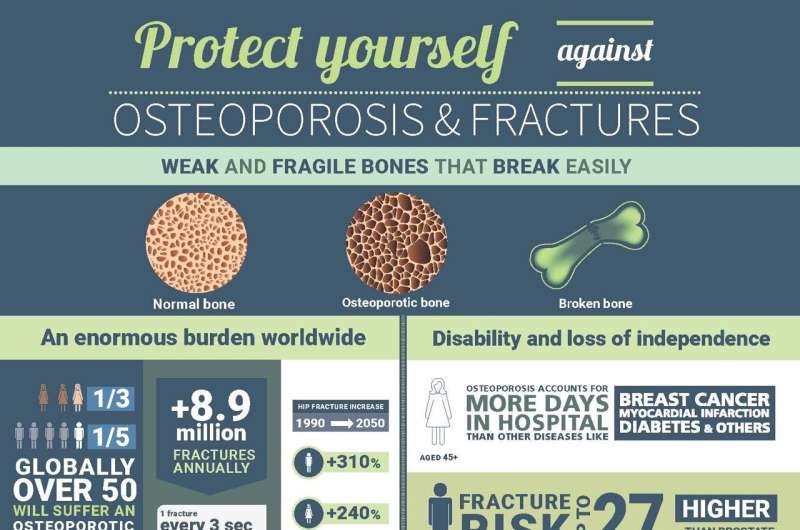This article has been reviewed according to Science X's editorial process and policies. Editors have highlighted the following attributes while ensuring the content's credibility:
fact-checked
trusted source
proofread
The top 10 recommendations to reduce the global burden of fragility fractures

National health care landscapes vary worldwide, but most share one common failing: Osteoporosis and fracture prevention are under-prioritized within the health care system.
Osteoporosis is a progressive, chronic disease that causes bones to become weak and fragile, resulting in a high risk of broken bones, known as "fragility fractures." In people with osteoporosis, a bone can break following a minor fall from a standing height, a bump, or even a sneeze. Globally, approximately one in three women and one in five men aged over fifty will sustain an osteoporosis-related fracture—often at the spine, wrist or hip.
Fragility fractures lead to costly surgeries, hospitalization, and rehabilitation, and in many cases, place a heavy burden on family caregivers or result in the need for long-term nursing home care. For the patient, there is an enormous impact on quality of life, mobility, and independence, and an increased risk of death: approximately 24% of hip fracture patients die within the year following their fracture. In Europe alone, more than 4.3 million fragility fractures occurred in 2019, at a cost of close to €57 billion.
Dr. Philippe Halbout, CEO of the International Osteoporosis Foundation (IOF), stated, "As populations age worldwide, we can expect a surge in the numbers of fragility fractures. By 2050, the global incidence of hip fracture is projected to increase by 310% in men and by 240% in women, compared to rates in 1990. For this reason, osteoporosis and fracture prevention must be urgently prioritized within health care systems."
Without treatment for osteoporosis, patients who have already suffered a fracture are at substantial risk of sustaining additional fractures within the next one to two years. In fact, up to half of the patients who present to hospital with a hip fracture have broken another bone in the months or years before breaking their hip.
Professor Maria Luisa Brandi, Chair of the IOF Capture the Fracture program, also noted, "It is critically important that all patients who have had a prior fracture receive timely intervention and treatment for osteoporosis to prevent further fractures. Unfortunately, the vast majority of people who have experienced a first fracture are not evaluated for osteoporosis.
"Indeed, studies have shown that approximately 80% of fracture patients worldwide are neither assessed nor treated for osteoporosis, the underlying disease. This is despite the availability of safe and effective medications, and clear medical management guidance that calls for treatment and follow-up."
IOF experts in collaboration with national osteoporosis experts have identified many key actions that health care systems can take to help prevent fragility fractures in the population. These have been outlined in recent IOF publications, including Capture the Fracture policy reports and audits, the major report Capture the Fracture Partnership Guidance for Policy Shaping and the landmark SCOPE: Scorecard for Osteoporosis in Europe Summary Report.
Although each country has its own specific health care landscape, priorities and challenges, there are a number of universally important components of any effective strategy to address the fragility fracture crisis.
The top 10 policy actions include:
- Mandating osteoporosis as a National Health Priority with the implementation of a national and/or regional action plan.
- Widely implementing Fracture Liaison Services for the routine assessment, management and follow-up of all individuals who have sustained a low trauma fracture.
- Ensuring high-quality information about the burden of disease through a national fracture registry, which includes hip and clinical vertebral fractures.
- Providing reimbursement for approved treatments to ensure accessibility for all those at high risk of fractures.
- Ensuring accurate identification of patients at risk of fracture through accessibility and adequate provision of DXA services and emerging technologies, as well as FRAX.
- Developing and disseminating high-quality management guidelines for osteoporosis, including guidance on the use of risk assessment tools, and ensuring that they are widely used in clinical practice.
- Reducing waiting time for surgery after hip fracture, as this has been associated with a significant reduction in mortality and better patient outcomes.
- Providing high-quality training in osteoporosis, including for primary care of osteoporosis patients, and ensuring that osteoporosis is a recognized and established component of specialty training.
- Supporting strong and effective patient organizations that can advocate on behalf of patients, working to raise public awareness, and collaborating closely with medical and research associations.
- Implementing systems to measure and audit the quality of care provided to people with osteoporosis and associated fractures.
IOF President Professor Cyrus Cooper stated, "Against the backdrop of World Osteoporosis Day, I strongly urge all health authorities to make osteoporosis and fracture prevention a health care priority. We must address this paradox: an explosion of fragility fractures as populations age, versus an unacceptable osteoporosis treatment gap that leads to immense human and socioeconomic costs.
"Furthermore, although the implementation of post-fracture care programs such as fracture liaison services is growing, we simply must increase the provision of these essential services which are still rare in most countries. Given the projected increase in fracture burden, we absolutely must do better. The 10 key actions we have identified can help save lives, reduce costs, and improve the quality of life of older adults in countries around the world."




















